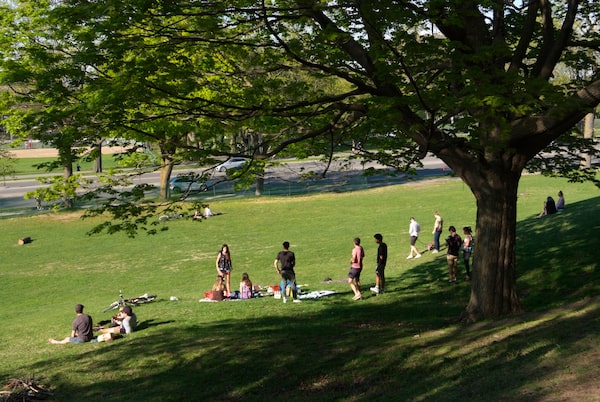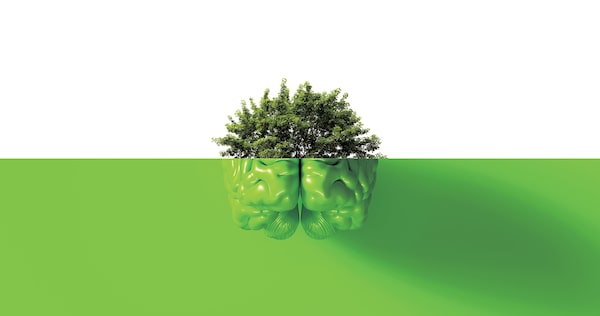
As Mount Royal looms in the background, Montrealers socialize apart in Jeanne-Mance Park last May, when the first wave of COVID-19 was beginning to ease in Canada.Kate Hutchinson/The Globe and Mail
As temperatures warmed last spring, Montrealers flocked to Mount Royal Park. Trapped inside – first by winter, then by lockdowns – the city’s residents were desperate for nature. The winding trails, lush forests and steep escarpments of Mount Royal offered an ideal remedy for their cabin fever. And as the pandemic has dragged on, the 700-acre green space has become such a popular destination that the city has repeatedly closed its parking lots to limit access during peak periods.
“The mountain has been intensely used during the pandemic,” says Juan Torres, a professor in the school of urban planning and landscape architecture at the University of Montreal, which is set on the north slope of the mountain. Unable to travel to Mexico to visit his mother and go to the sea, Prof. Torres and his family have spent much of the past year exploring the mountain and the island’s riverside green spaces. “It has been a great stress reliever,” he says.
Humans, it turns out, often seek out nature more earnestly in times of crisis. War, pandemics and natural disasters have led to the launch of community gardens for veterans and widows, and compelled people to tend to trees that survived bombings. That phenomenon, called “urgent biophilia,” may bring emotional balance to people overwhelmed by a crisis.
The magic and the mystery of Toronto’s ravines

A cyclist rides over the Lions Gate Bridge as Stanley Park, one of Vancouver's signature urban wildernesses, stands beside it.Jonathan Hayward/The Canadian Press
Urban nature is important for mental health over all – city dwellers who live near green spaces are less depressed and anxious than those who don’t.
More people are grasping nature’s benefits as the pandemic has put people out of work, forced families to juggle jobs and school from the kitchen table and curbed social interactions.
In a national survey from the not-for-profit group Park People, 82 per cent of Canadians said parks had become more important to their mental health during the pandemic, and 55 per cent of cities said park use had increased.
“Many people may think that urban nature is nice to have, that it’s pretty or a bonus. But actually, it’s absolutely essential to our mental and physical health,” says Carly Ziter, an urban landscape ecologist at Concordia University.
Nature in cities provides people with a place to exercise. Parks also gives people places to socialize with friends and family, which makes people happier. During the pandemic, urban green spaces have become rare hubs of acceptable social activity when public-health authorities have urged people to stay one caribou (Yukon), two lobster traps (Halifax) or three racoons (Toronto) apart.
But research suggests there’s something about how our brains interact with nature that yields psychological benefits. A visit to a natural area delivers sights, sounds and smells – the varied greens of a spring forest; the trill of a redwing blackbird; the whiff of petrichor, the earthy odour produced after rain falls on dry soil – that can improve our mental health by resetting our mood, focus and creativity.
With more than 80 per cent of Canadians now living in urban and suburban environments, understanding the links between nature and mental health could go a long way to improving our well-being. City dwellers tend to be healthier over all than their rural neighbours, except when it comes to mental health. They are 20 per cent more likely to have anxiety and 40 per cent more likely to develop depression.

A male downy woodpecker takes a peanut from a visitor to an urban waterfront park in western Toronto.Natalie Robertson/The Globe and Mail
Scientists are still untangling how nature benefits our brains. One idea is that attention is a finite resource and that focusing on many tasks leads to mental fatigue. “We’ve become Zoom zombies,” says David Strayer, a cognitive neuroscientist at the University of Utah. “We’ve surrounded ourselves with all this technology and it is taxing the brain – we’re constantly multitasking.”
Nature appears to restore attention. Part of the effect may be simply leaving behind all the devices that ping, ding and beep-beep. “A honking horn triggers a neural mechanism in the brain that is part of the flight-or-fight response,” Dr. Strayer says. “It alerts the person that there’s a hazard, which is good, but we are now being constantly triggered by this technology.”
In a 2012 study, Dr. Stayer and his team presented hikers with a series of puzzles that tested creative thinking and problem solving. Each question on the test, called the “remote associates test,” lists three words and asks the test-taker to identify the fourth word that links them. The answer to the question, “opera, hand, dish” would be “soap.”
Half the hikers took the test before they left for a trip. The others backpacked in Alaska, Colorado or Washington for three or four days – without electronic devices – and answered the questions on their fourth day in the wilderness. The nature-immersion group solved 50 per cent more puzzles than the control group.
Another idea is that natural landscapes activate a part of the brain that reduces stress. The dancing flames of a campfire or the slow rolling waves of the ocean can gently draw our attention.
“When you’re walking in a city, there are taxis going by and crowds,” says Robin Mazumder, an environmental neuroscientist. “But when you remove all that, you only have to exist.”

Downtown Calgary's office buildings loom behind a riverside trail earlier this month.Sarah B. Groot/The Globe and Mail
Simply seeing nature, even through a window, appears to boost well-being. People who see trees, flowers and grass recover from surgery faster (and take fewer narcotic painkillers), than those with views of brick or concrete. They also do better in school and are generally happier.
Researchers began studying these links 40 years ago. In a now famous study, they surveyed hundreds of office workers (mostly women) about the view they had from their workstations. Some didn’t have windows at all, but those who could see nature were less frustrated, more patient, expressed greater enthusiasm for their jobs and had greater overall health than their colleagues.
Last year, researchers asked 3,000 people living in Tokyo, which was under a state of emergency at the time, about what they could see from their windows at home and to rate their mental health. People who saw roadside trees, gardens, parks and woodlands reported greater self-esteem, life satisfaction and happiness, as well as less loneliness, depression and anxiety.
The results, the authors wrote, were “especially relevant during the COVID-19 pandemic, when people are experiencing increased levels of stress and are confined in isolation in their homes.”
A growing number of studies find that green spaces directly affect physiology. People who spend time sitting or walking in a forest have lower cortisol levels, blood pressure and heart rates. In short, nature calms them down.
But what is it that causes these benefits? Neuroscience data is limited – in part because of the challenges of recording brain waves and function while outdoors – but scientists are starting to tease these strands apart.
In a 2015 study, researchers looked for changes in the brain activity of healthy people who walked through natural areas compared with high-traffic urban areas. Participants walked in a grassland studded with oak trees or next to a noisy four-lane roadway for 90 minutes. Back at the lab, they filled out a questionnaire and had their brain activity gauged by a machine that measures metabolic activity called an fMRI.
Those who had walked in nature had less activity in the subgenus prefrontal cortex, a part of the brain that’s especially active during rumination – obsessive thinking about dark or sad ideas or situations – compared with those who had walked through the urban environment.
In his research, Dr. Strayer has been taking people into the Utah wilderness, and connecting them to a portable EEG to measure brain waves while they hike through grasslands or sit along a riverbank. He’s found that the anterior cingulate cortex – a brain hub that’s active when we multitask – quiets down when people “unplug from technology and plug into nature.” Other studies using fMRI show that nature shifts activity from the brain networks involved in attention to those associated with mindfulness and meditation.

Humans and Canada geese keep a respectful distance at Vancouver's Sunset Beach.Darryl Dyck/The Canadian Press
Sound also influences our moods. Cities are filled with din. Buses moan and screech, trains clatter by and traffic helicopters circle overhead. That cacophony has been linked to sleeplessness, stress and a higher risk of hypertension and heart attacks.
Natural noise, such as rustling leaves, chirping birds and the gentle lap of waves on the shore, might help reverse those effects. From an evolutionary perspective, “an acoustic environment that is full of natural sounds is a good indicator of safety,” says Rachel Buxton, a conservation scientist at Carleton University. “It says, ‘Everything is okay,’ and we tend to let our guard down.”
In a new study, Dr. Buxton and her colleagues reviewed dozens of studies and found natural soundscapes helped with mental recuperation. Birdsong had the largest effect on reducing stress and annoyance, while water sounds had the greatest impact on health and feelings of tranquility. They even found that listening to natural sounds in urban parks, amidst traffic sounds, had rewards.
“It’s encouraging because we can do things, we can have these nature-based solutions in urban areas,” Dr. Buxton says.
As the evidence grows, health care professionals and policy makers are looking for ways to develop health interventions that incorporate nature.
Some doctors in the United Kingdom, United States and parts of Canada are prescribing nature activities, such as beach walks or bird watching, to help mental illness, diabetes, heart disease and stress. Cities are expanding their tree canopies and adding green spaces to greyer neighbourhoods.
“After the experience we are having now … it will be easier for municipalities to take forward these kinds of policies,” says Prof. Torres of Montreal.
But not everyone likes a rough trail or an English garden. “We really have diverse relationships with nature,” says Lorien Nesbitt, a University of British Columbia professor studying urban forestry and environmental justice. Cities should consult with communities about their needs to get the greatest benefits from their plantings. “For some, that’s going for a walk in a park or doing sports; for others it is growing food, or a traditional cultural practice.”
The pandemic has revealed the lack of essential urban green spaces. Montreal, Toronto and other cities in Canada have at times closed parking lots to its most popular parks and told people to stay close to home. The pandemic has pushed people outside, Prof. Torres says, but it has also “shown the inequity, the huge differences between neighbourhoods, and who may not have access to interesting areas.”
As cities expand, they chew into the few remaining natural areas, clearing forests and paving over wetlands. “We have to prioritize development in other areas when we can, and conserve the natural areas we have left,” says Concordia’s Dr. Ziter.
Many cities are adding green space. Montreal, for example, plans to boost its tree canopy to 25 per cent, from 20 per cent, by 2025, and will plant 500,000 trees by 2030 on public and private land, with a focus on heat-vulnerable neighbourhoods such as Montréal-Nord and Mercier–Hochelaga-Maisonneuve. Providing access to safe, inclusive and culturally meaningful green spaces could improve mental health and reduce inequities in lower-income neighbourhoods and racialized communities.
“I’ve had teachers tell me that they don’t go outside in September because it is too hot in the schoolyards,” says Malin Anagrius, an urban ecologist and the general manager of Soverdi. The organization has already helped plant hundreds of thousands of trees on the island at long-term care homes, industrial sites and schools.
Dr. Ziter applauds cities’ efforts to increase urban nature, but says they can do more. “Just as we plan for and maintain our grey infrastructure – our buildings, our bridges – it’s really critical that we plan for and maintain our ecological infrastructure in cities, too.”

Photo illustration by The Globe and Mail (source: iStockphoto)